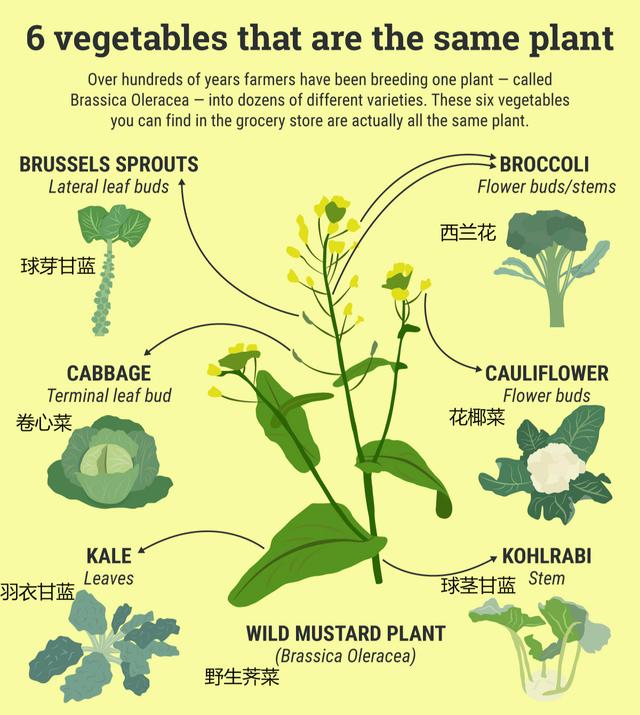
图形解析:花椰菜的变种
You may never have heard of the plant Brassica Oleracea, but you've definitely eaten it.
你可能从未听说过花椰菜,但你一定吃过。
Six vegetables you can find in any grocery store and which most people eat on a regular basis are actually all from this one plant. Over the last few thousand years, farmers have bred Brassica Oleracea into six "cultivars" that eventually became many of the vegetables we eat.
杂货店容易见到的六种蔬菜,大家也常常吃这几种蔬菜,但事实上,这六种蔬菜都是一种蔬菜的变种。过去几千年中,农民培育出很多花椰菜的变种,并最后衍变成了大家今天吃的很多蔬菜。
This one plant was selectively bred over hundreds of years to create dozens of wildly different vegetables. By selecting and breeding plants with bigger leaves, or larger buds, the different cultivars were created.
几百年间,大家有选择的对这种植物进行培育,并成功培育出几十种不一样的野生蔬菜。通过选择和培育那些叶子较大、芽较健壮的品种,大家创造出很多该植物的变种(也称之为亚种)。
Kale, collard greens, and Chinese broccoli were created by making the leaves of the ancestor plant's leaves bigger, and were the first brassica domesticated, sometime before 300 BCE. Collard greens were developed in Europe, while Chinese broccoli was domesticated in China.
通过使得前人培育植物的叶子更大,大家培育出了羽衣甘蓝和芥蓝;公元前300年左右,大家培育出了第一批芸苔。羽衣甘蓝是欧洲人培育出来的,而荠蓝是中国人培育出来的。
Red, green and savoy cabbages were created from a kale cultivar in the 1200s by selecting for a large terminal bud — the growing end at the TOP of the plant. The leaves are tightly wound around a short, wide stem .
13世纪左右,通过对羽衣甘蓝变种的芽进行选择性培育,大家培育出了红球甘蓝、卷心菜和萨沃伊白菜。他们的叶子紧紧地缠在那又短又宽的茎上(白菜心)。
Brussels sprouts are like tiny cabbages, except they grow from the buds along the plant’s stem. They first hit the scene in the 1200s as well.
球芽甘蓝非常像微型的大白菜,但球芽甘蓝的果实沿着茎成长。球芽甘蓝也是在13世纪左右初次出现的。
Kohlrabi was created by selecting for a thicker stalk in a kale plant around the 1400s.
通过对茎体较粗的羽衣甘蓝进行选择培育,大家又在15世纪左右培育出了大头菜。
Broccoli was created from a kale predecessor in the 1500s by selecting for the larger flower clusters, which are then harvested before they bloom. Cauliflower was developed from one of hundreds of broccoli varieties.
通过对花体较大的羽衣甘蓝进行选择性培育,大家又在16世纪左右培育出了西兰花;这种植物开花前就能进行收割了。而花菜又是从上百种西兰花变种中培育出来的。
The amazing evolution of Brassica Oleracea just goes to show: Humans have been tinkering with the genetics of our food for much longer than we've been creating what are now known as genetically modified foods, or GMOs. These new lab techniques just let us do it in a more precise and directed way.
花椰菜的衍变历史叫人惊讶,从中不难发现,人类改变食物基因所用的时间要长于创造转基因食物的时间。这类新技术让大家可以愈加精准直接的培育植物。






